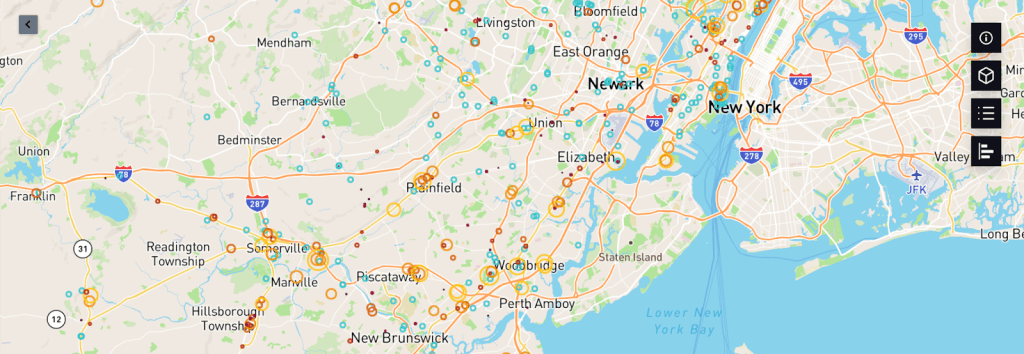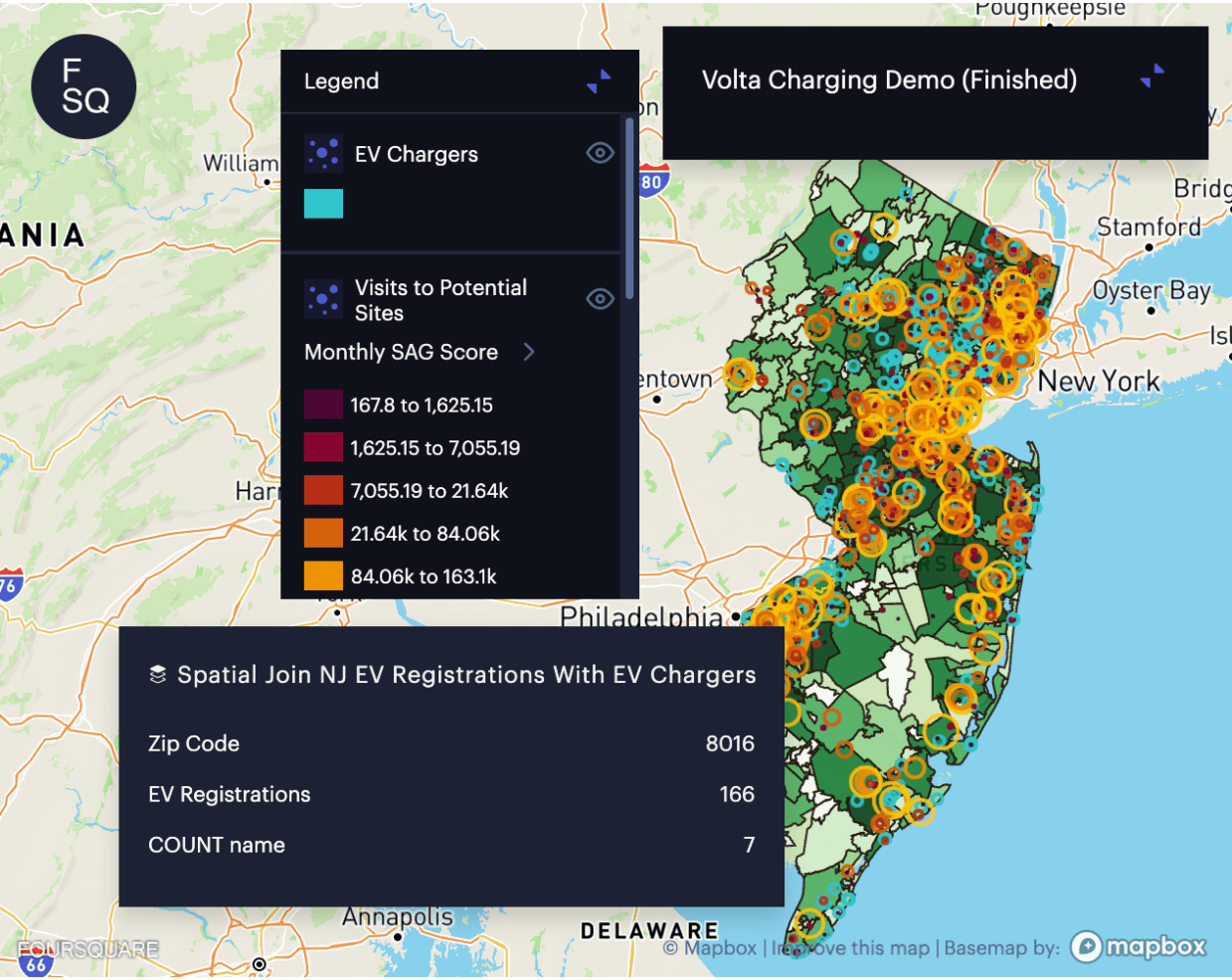With the US EV market expected to grow to nearly 137B by 2028, up from 28B in 2021, more companies are beginning to invest in EV network data and integrating it into their decision-making processes. Industries like charge point operations, real estate, consumer apps, and many more stand to benefit by expanding databases and maintaining knowledge of where these EV charging stations are located.
Investing, integrating, and planning for the coming changes will only help companies plan for the future and make effective, data-driven decisions. Maintaining an accurate and continuously updated database of the grown networks will simplify the countless use cases that these insights enable.
Here are some ways EV POI are powering and enabling some of today’s use cases.
Use Cases
Site Selection
If you’re a charge point operator (CPO) building out a network of EV stations or retailers looking into opening up a new retail location, the location of nearby EV charging stations can provide valuable insights into an area. A higher number of EV stations is usually a strong indicator of more amenities, better walk scores, higher incomes, home values, and many other demographic insights. Below, we’ll cover how existing EV charging stations provide critical insights into how you should go about planning your business.
1. EV Charging Networks
For companies looking to build their charging networks, knowing where EV chargers are and aren’t located is essential in deciding where to allocate resources effectively. Unfortunately, assessing the most suitable locations for a network requires significant data and insights into the surrounding area. While data is publicly available, it is usually challenging to obtain, aggregate, and validate.
Developing an effective model for site selection and analysis is extremely challenging due to the wide range of external factors and data needed. Because of this, having an accurate, robust, and up-to-date dataset is essential to gaining the necessary insights. Good data-driven decisions enable users to select locations that aren’t already saturated or won’t go underutilized.
When considering where to build out EV Networks, CPOs must become geospatial experts in their target areas and take advantage of all possible datasets to maximize profitability.
A great starting point is, at the very least, considering the following points.
- Current charging locations and type
- Population density and movement
- EV drivers located within reasonable proximity to network
- Nearby points of interest that may attract travelers (shopping centers, parks, etc.)
- Demographics (income, type of housing, employment, etc.)
- Property values
- Weather and seasonal effects on mobility
- Transportation corridors, airports, and other transportation centers
As part of a site selection process, companies should seek to factor all POI, demographic, and human movement data into their decision-making process. In addition to Places and demographic data, FSQ enables users to tie Visits data into their site selection process. With this, users may analyze an area’s foot traffic in unison with the surrounding POI. Doing so, companies can answer the question of where to build out their networks while addressing gaps and avoiding areas that are already over or under-saturated.
EV charging stations are an important POI to monitor in your decision-making process, but they are not the be-all and end-all. A well-rounded data-driven approach is necessary to make an informed decision. Your data should combine all aspects of location intelligence. Through Places and Visits, FSQ gives you all the insights necessary for analysis and site selection. Models should not only focus on the charging stations themselves, but also provide insights into the surrounding amenities – this gives an understanding of nearby POI and why people are charging there.
In addition to data, Foursquare Studio is a tool that enables users to visualize all their Visits and Places data in one place, while also running analysis on their target location. Users of Foursquare Studio can quickly and easily tie in various types of data and create customizable filters that simplify data ingestion and digestion.
We’ve built a real-life Studio demo Mapping EV charging station that you can explore below:
In the Studio demo above, we see where a high volume of visits occur relative to EV charging stations (blue dots) and the overall volume of EV registrations in the area.

Here we see the same map with EV registrations removed. In this version, we see the pattern of charging stations being located near areas of high visit traffic or major highways.
2. Retailers
For brick-and-mortar stores, more traffic typically means more dollars. Being within walking distance of an EV location is an opportunity to generate more traffic, as each car that pulls in could equal another person looking to kill 30 minutes. An EV station could be an amenity your competitors do not provide, incentivizing drivers to patronize your business. As a driver, it’s a time to shop, eat, or spend money on other forms of entertainment. This is evident by the high number of charging stations near big box stores, malls, and strip malls. Some CPOs, like Volta, even offer the ability to advertise through their charge points, allowing businesses to enhance visibility and connect with consumers. It may not be critical to be near an EV station, but it is something to be aware of during your site selection process as it attracts a particular type of clientele and may give your brand an eco-friendly image.
Mapping & Fleet Management
For companies like Uber, Lyft, or any others managing a fleet of EV vehicles, having an up-to-date database on the location of EV charging stations is critical to keep a growing percentage of their EVs on the road. A current and robust database means drivers spend less time looking for charging locations and more time on the streets.
Companies should look for a data provider that routinely adds to their growing list and validates their data with 1st party resources. Having a firm POI count is excellent, but as networks are continuously built out, it’s critical that your data provider continuously grows their database in a timely manner.
Building Apps & User Experiences
Industries like travel and hospitality are always looking for ways to provide customers with the most relevant insights during their journeys or stays. Hotels, car rental agencies, navigation apps, and many more, can benefit from providing their customers with nearby EV stations as an added convenience within their customer experience. While not a ground-breaking feature, it’s an additional touch point that could set you apart from competitors in a crowded industry.
The more information you can quickly and reliably surface means users won’t be incentivized to look elsewhere and will spend more time engaging with your product.
Conclusion
Maintaining an accurate and continuously updated EV charging database will be crucial in powering future business decisions. Some EV charging station data is available from different agencies but is usually spread out, difficult to obtain, or varies in quality. For those interested in EV data, Foursquare navigates all complexities to give you an accurate and growing one-stop shop for all your geospatial needs. We recently added over 11K new EV stations to our database, and are continuously searching for and validating new POI. For a sample dataset and Studio map, click here.
Schedule a call today to learn how Foursquare can power your business use cases.



